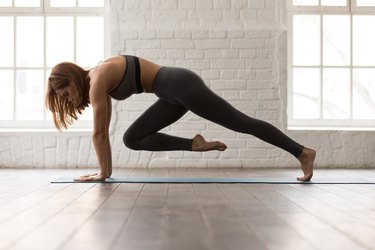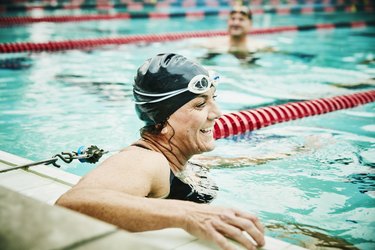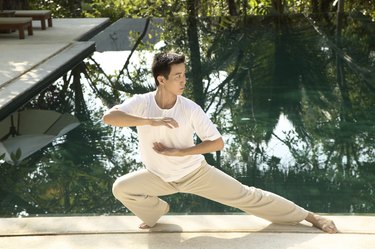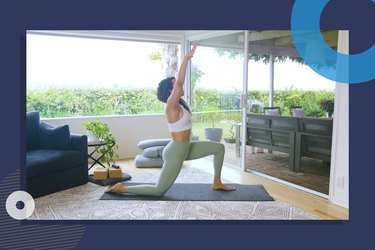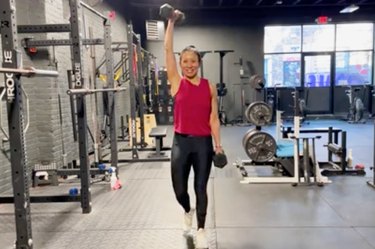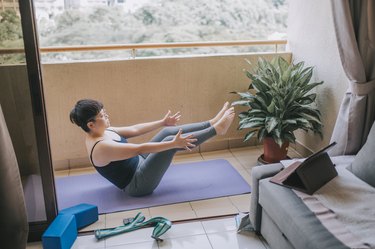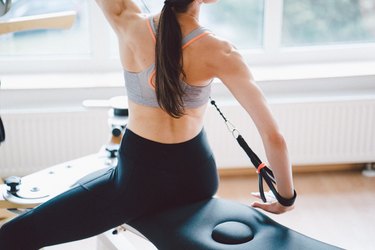
A flowing, full-body movement system, the Gyrotonic Method is an exercise technique that may look intimidating, but is touted to give great results, including more agility and strength. But does it live up to the hype?
Using specialized equipment, Gyrotonic exercise combines movements similar to tai chi, yoga and Pilates to help improve strength, balance and flexibility. It's a flowing routine that's becoming popular with celebrities and physical therapists alike. We spoke to experts and looked at the research to find out more.
Video of the Day
What Is the Gyrotonic Method?
"I like to explain Gyrotonic as yoga with an exercise machine, [called] the Gyrotonic Tower," physical therapist and Gyrotonic instructor Stephen Dunn, PT, owner of CORE Therapy & Pilates, says. "This machine guides and assists you in determining the appropriate breath work and movement for optimal posture."
The Gyrotonic Tower uses a weighted pulley system, along with an adjustable bench and rotating handle unit, so it can be used in many different ways for a customized exercise program. "The handles on the Gyrotonic Tower are what really give this system its greatness, as rotation is added to the mix with arching and curling," Dunn says.
There are other pieces of add-on equipment that can also be used, such as a jumping and stretching board, as well as an archway.
The goal of Gyrotonic exercise is to improve strength (with the weighted pulleys), improve flexibility and mobility, as well as sharpen your coordination — and you are working on these things all at the same time. Instead of a typical exercise where you may stand and do 20 biceps curls, for example, with Gyrotonic exercise you follow a flowing exercise sequence that moves from one exercise to the next. It involves lots of rotating of the spine and circular motions with the upper body and lower body.
You may use straps to connect to the pulleys while standing and reaching out to each side — or straps can go on your feet to work your legs in circular motions. You may be sitting on the tower and holding onto the handles and rotating your body side-to-side. You can also stand on the moving pedals to work your lower body. The video below gives an idea of what type of movements to expect.
Although you can purchase this equipment for home use, it is advisable to first learn the method by taking classes in a private or group setting with a certified instructor at a studio or physical therapy clinic.
The Gyrotonic website allows you to search for a certified instructor near you according to location. The prices of the classes will vary by location. If you purchase the equipment for home use, costs start around $6,000 and go up from there.
Benefits and Limitations of the Gyrotonic Method
The Gyrotonic Method can be used in conjunction with physical therapy when treating conditions such as back pain, shoulder pain, neck pain and even hip and shoulder injuries. It is also used to strengthen postural muscles and to address muscle imbalances to prevent injury, as well as for athletes who want to improve performance.
Dunn has been using the Gyrotonic method in his physical therapy practice since 2009 and says, "pain relief from weakness and lack of mobility is the greatest benefit I have seen."
"The benefits of the Gyrotonic method start with improved posture, awareness and strength. It helps you find the little muscles that are often neglected," he says. "People who are suffering from pain, recovering from surgery or have neurological conditions all benefit from Gyrotonic exercise."
"This specialty exercise was developed by Juliu Horvath, a Romanian-born Hungarian dancer and athlete," explains Karena Wu, PT, DPT, physical therapist and owner of ActiveCare Physical Therapy. "This exercise opens up the body, uses multiple joints and muscles at the same time and moves across three planes. It benefits your system by increasing range of motion, muscle activation, flexibility and stability. Because of its whole body and kinetic chain motion, it can mobilize fascia and nervous tissue."
The three planes of motion are sagittal (right and left), frontal (front of your body and back of your body) and transverse (top of your body and bottom of your body). Most exercises just work one or two planes at the same time, while with the Gyrotonic Method you are constantly moving into all three planes, making it a highly functional exercise.
Although the benefits sound promising, there isn't much research at this point to back it up. More peer-reviewed studies with larger sample sizes and those that look at a wider variety of conditions are needed to verify the benefits of the Gyrotonic Method. Here is what the research has shown thus far.
A very small February 2019 study in the Journal of Exercise Rehabilitation compared the Gyrotonic Method to trunk stability exercises in 26 people with chronic low back pain. The two groups (one Gyrotonic, one stability exercises) performed the exercises three times a week. After four weeks, the researchers found both groups improved, however, there were no significant differences between the two methods. They were both equally effective. More studies are needed with a larger group over a longer period of time.
A February 2016 study in the Journal of Physical Therapy Science looked at the effect of eight weeks of the Gyrokinesis Method on women who had altered gait (or altered walking patterns) due to chronic low back pain. (We're using the language for sex and gender used by the primary source.) The Gyrokinesis Method uses similar moves as the Gyrotonic Method, however, it doesn't require the use of the Gyrotonic Tower. They found an improved gait pattern, including step length and stride speed after Gyrotonic exercise. An older, unpublished 2003 clinical study on only five people found that Gyrotonic exercise was helpful for those who had scoliosis.
Pros
- Pulley Tower provides resistance to strengthen your muscles
- Improves mobility by taking your joints through their full range of motion
- Low-impact exercise that can be customized according to your fitness level
- Strengthens core and may improve spinal mobility
- May improve coordination and proprioception
- The constant motion and different exercise sequences help reduce exercise boredom
Cons
- Requires the use of specialized equipment, called the Pulley Tower
- Not as accessible as other exercise methods, as it requires instruction by a certified trainer
- Whether you pay for an exercise session or purchase the Pulley Tower, it can be expensive
- More research is needed to verify the benefits of the Gyrotonic Method over exercises such as Pilates and yoga
- You don't get the bone strengthening and cardiovascular benefits of more high-impact exercises, such as running, jumping, or HIIT
What to Expect at a Gyrotonic Session
Gyrotonic sessions are either private lessons or in a small group setting. Your certified Gyrotonic instructor will cater your session according to any injuries, as well as muscle imbalances and weakness. Most people will take one to three classes per week, depending on goals, schedule and budget. Session times vary in length, but most last about an hour.
Dunn often uses Gyrotonic exercises in conjunction with his physical therapy treatment plans. "One could expect to have some manual therapy, known as myofascial release, and home exercise instruction followed by Pilates and Gyrotonic-based exercises. I then progress patients to work with my Gyrotonic trainer after they are discharged from therapy."
"I start by teaching my patients stability of the pelvis and spine on the Pilates Reformer and progress them to Gyrotonic exercises for sitting and sport or work-specific training."
Your instructor will take you through several fluid movements. "Consider the cat-cow or cow-camel, as described in yoga," Dunn says. "That motion of the spine is what we call an arch-curl in Gyrotonic exercise. In yoga, this is performed in quadruped, or hands and knees, but in Gyrotonic exercise, it is performed while sitting, standing and in other dynamic movements."
He explains that the handles on the tower that provide the rotation component aids in this movement. "This is the three-dimensional or rotational component that differentiates it from Pilates."
Alternatives to the Gyrotonic Method
Although the Gyrotonic Method appears promising, it requires specialized equipment and instruction — which can get expensive and time-consuming, especially if you don't have a studio nearby. There are other alternatives that offer similar benefits to the Gyrotonic Method:
- Gyrokinesis: The Gyrokinesis Method uses the same basic movement techniques of Gyrotonic exercise, but without using the Tower equipment. It only requires a mat and a chair. You can take virtual classes or videos to learn the technique, with most classes lasting 1 to 1.5 hours.
- Pilates: Pilates also uses specialized equipment (the Reformer) and helps to improve flexibility and overall strength, including core strength. "Gyrotonic exercise incorporates the breath and multiple planes of movement. Pilates emphasizes the core, posture, breath and repetitive movements," Wu says.
- Yoga: Yoga can also give you strengthening and flexibility benefits similar to Gyrotonic. Vinyasa yoga is faster-paced with flowing sequences, similar to Gyrotonic exercise, while other types of yoga, such as Hatha yoga, are slower with longer, sustained holds. "Yoga emphasizes a series of poses, breath and mental focus/relaxation," Wu says.
- Spinal Stabilization Exercises: If you are considering the Gyrotonic Method to help relieve or prevent back pain, trunk or spinal stabilization exercises (such as the plank and dead bug) are just as effective, according to the study in the Journal of Exercise Rehabilitation.
- Swimming: Swimming improves strength and cardiovascular health and is a good choice if you who want a low-impact exercise that won't strain your joints.
- Tai Chi: Tai chi helps improve strength, flexibility and balance and has more fluid movements, similar to Gyrotonic exercise. No equipment is needed for tai chi, however.
Start With These Workouts
- Gyrotonic.com: "The Gyrotonic Expansion System"
- Journal of Exercise Rehabilitation: "The Effects of Gyrotonic Expansion System Exercise and Trunk Stability Exercise on Muscle Activity and Lumbar Stability for the Subjects With Chronic Low Back Pain"
- Journal of Physical Therapy Science: "Effects of Gyrokinesis Exercise on the Gait Pattern of Female Patients With Chronic Low Back Pain"
- Kaiser Sports: "A Clinical Study of the Gyrotonic Expansion System for the Treatment of Scoliosis"
- Gyrotonic.com: "Gyrokinesis Method"
- American Council on Exercise: "Pilates: Health Benefits, How to Get Started, and How to Get Better (Everyday Health)"
